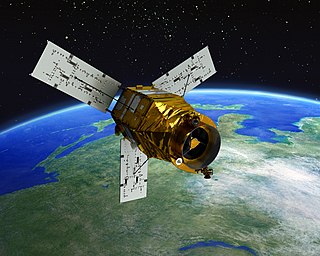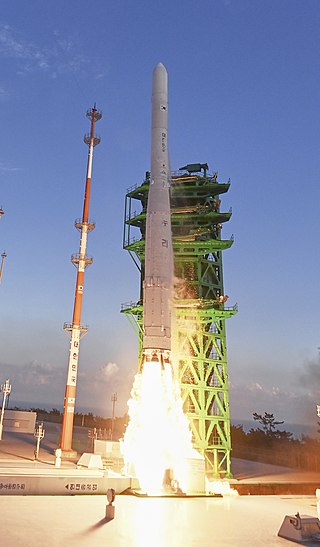
An Earth observation satellite or Earth remote sensing satellite is a satellite used or designed for Earth observation (EO) from orbit, including spy satellites and similar ones intended for non-military uses such as environmental monitoring, meteorology, cartography and others. The most common type are Earth imaging satellites, that take satellite images, analogous to aerial photographs; some EO satellites may perform remote sensing without forming pictures, such as in GNSS radio occultation.

DigitalGlobe was an American commercial vendor of space imagery and geospatial content, and operator of civilian remote sensing spacecraft. The company went public on the New York Stock Exchange on 14 May 2009, selling 14.7 million shares at US$19.00 each to raise US$279 million in capital. On 5 October 2017, Maxar Technologies completed its acquisition of DigitalGlobe.

Satellite images are images of Earth collected by imaging satellites operated by governments and businesses around the world. Satellite imaging companies sell images by licensing them to governments and businesses such as Apple Maps and Google Maps.
IKONOS was a commercial Earth observation satellite, and was the first to collect publicly available high-resolution imagery at 1- and 4-meter resolution. It collected multispectral (MS) and panchromatic (PAN) imagery. The capability to observe Earth via space-based telescope has been called "one of the most significant developments in the history of the space age", and IKONOS brought imagery rivaling that of military spy satellites to the commercial market. IKONOS imagery began being sold on 1 January 2000, and the spacecraft was retired in 2015.
QuickBird was a high-resolution commercial Earth observation satellite, owned by DigitalGlobe, launched in 2001 and reentered after orbit decay in 2015. QuickBird used Ball Aerospace's Global Imaging System 2000. The satellite collected panchromatic imagery at 61 centimeter resolution and multispectral imagery at 2.44- to 1.63-meter resolution, as orbit altitude is lowered during the end of mission life.

The Korea Aerospace Research Institute, established in 1989, is the aeronautics and space agency of South Korea. Its main laboratories are located in Daejeon, in the Daedeok Science Town. KARI's vision is to continue building upon indigenous launch capabilities, strengthen national safety and public service, industrialize satellite information and applications technology, explore the Moon, and develop environmentally-friendly and highly-efficient cutting-edge aircraft and core aerospace technology. Current projects include the KSLV-2 launcher. Past projects include the 1999 Arirang-1 satellite. The agency was founded in 1989. Prior to South Korea's entry into the Institute for Advanced Engineering (IAE) in 1992, it focused primarily on aerospace technology.
The Disaster Monitoring Constellation for International Imaging (DMCii) or just Disaster Monitoring Constellation (DMC) consists of a number of remote sensing satellites constructed by Surrey Satellite Technology Ltd (SSTL) and operated for the Algerian, Nigerian, Turkish, British and Chinese governments by DMC International Imaging. The DMC provides emergency Earth imaging for disaster relief under the International Charter for Space and Major Disasters, which the DMC formally joined in November 2005. Other DMC Earth imagery is used for a variety of civil applications by a variety of governments. Spare available imaging capacity is sold under contract.

KOMPSAT-1, also known as Arirang-1, was a satellite created by the Korea Aerospace Industries (KAI) and Korea Aerospace Research Institute (KARI), and launched by a United States launch vehicle on 21 December 1999. This was the first satellite built primarily by South Korean engineers, although previous foreign-built satellites had been launched by Korean companies. It took its name from the popular Korean folk song Arirang.

GeoEye Inc. was an American commercial satellite imagery company based in Herndon, Virginia. GeoEye was merged into the DigitalGlobe corporation on January 29, 2013.
KOMPSAT or Korean Multi-Purpose Satellite is a series of South Korean multipurpose satellite for Earth observation, communications, meteorological, environmental, agricultural, and oceanographic monitoring applications.
The STSat-1, formerly known as KAISTSat-4, is an ultraviolet telescope in a satellite. It is funded by the Korea Aerospace Research Institute (KARI), and was launched on 27 September 2003, from Plesetsk Cosmodrome by a Kosmos-3M launch vehicle, into an Earth orbit with a height between 675 and 695 km.

KOMPSAT-3, also known as Arirang-3, is a South Korean multipurpose Earth observation satellite. It was launched from Tanegashima Space Center, Japan at 16:39 UTC on 17 May 2012. Like the earlier KOMPSAT-1 and KOMPSAT-2 satellites, it takes its name from the popular Korean folk song Arirang. Its launch was the culmination of a project begun in 1995.

STSat-2A was a satellite launched by the Korea Aerospace Research Institute (KARI), the national space agency of South Korea, from the Naro Space Center in Goheung County, South Jeolla using the Naro-1 (KSLV-1) launch vehicle.

Nuri, also known as KSLV-II, is a three-stage launch vehicle, the second one developed by South Korea and the successor to Naro-1 (KSLV-1). Nuri is developed by Korea Aerospace Research Institute (KARI). All three stages use indigenously developed launch vehicle engines, making Nuri the first indigenously developed South Korean orbital launch vehicle.
SEOSat-Ingenio, was a Spanish project to produce a satellite capable of providing wide-field imagery ensuring a repeat cycle of 38 days at 2.5 metre panchromatic resolution and 10 metre colour resolution, from a Sun-synchronous polar orbit; it was Spain's first optical imaging satellite. The satellite was part of the Spanish Earth Observation Satellite program. The mission was funded by Spain's Centre for the Development of Industrial Technology (CDTI). SEOSat-Ingenio information was to be used by various Spanish civil, institutional or government users. However, under the Copernicus Programme of the European Union, it was also accessible to other European users, as well as to the Group on Earth observation of the Global Observing System of Earth.

Vegetation and Environment monitoring on a New Micro-Satellite (VENμS) is a near polar Sun-synchronous orbit microsatellite. It is a joint project of the Israeli Space Agency and CNES. The project was signed upon in April 2005 and was launched on the 2nd of August 2017. The microsatellite, which was set to cost the ISA US$20 million and CNES €10 million, was designed and built by IAI and Rafael under ISA's supervision.
Seung Jo Kim is a South Korean aerospace engineer. He has been the current President of Korea Aerospace Research Institute (KARI) since June 2011, where the most of the national aerospace systems like aircraft, satellites and rockets are developed. During his tenure, Kim led the development of smart Unmanned aerial vehicle (UAV), the launch of KOMPSAT-3, KOMPSAT-5, STSat-3 and the first Korean space launch vehicle, Naro-1. Before becoming president of KARI, Kim had been a professor of the Engineering College at Seoul National University since 1986. He chaired the KSAS in 2009, the KSCM from 2005 to 2006, and the KSIAM from 2004 to 2008. He was also head of the New Aerospace Technology Research Institute from 2001 to 2003. Kim has been a fellow of the American Institute of Aeronautics and Astronautics (AIAA) since 2010 and the Institute of Physics since 2004.
The National Space Program (PSN) horizons 2020 planned to put in place space infrastructures, space systems and increase the specialized human resources in space technologies. Among the space systems planned in the PSN are Algeria's satellites, of which a significant number should be partly or totally integrated in the Algerian center for satellite development "CDS". CDS offers the technological environment for national competence to develop the future Algerian satellite systems. Algeria's objectives is to make of space tools a powerful instrument in national prosperity in the fields of earth observation, meteorology and communications.

Satrec Initiative or SI is a South Korean satellite manufacturing company headquartered in Daejeon, South Korea The company was founded in 1999 by the engineers who developed the first Korean satellite (KITSAT-1) at KAIST SaTRec. The company designs and builds Earth observation satellites called SpaceEye-series, and it provides various space components, including high resolution electro-optical payloads and star-trackers. SI's first satellite was a Malaysian Earth observation satellite, RazakSAT launched in 2009. SI has two subsidiaries: SI Imaging Services (SIIS) is the exclusive image data provider of KOMPSAT-series, and SI Analytics (SIA) provides AI-native GEOINT solutions for satellite imagery. SI also spun-off SI Detection (SID), which provides radiation monitoring solutions.
EOS SAT-1 is an optical Earth observation satellite for agricultural land monitoring by EOS Data Analytics, Inc., a global AI-powered satellite imagery analytics provider. The space optics instrument and satellite manufacturer Dragonfly Aerospace built the satellite and equipped it with two high-resolution DragonEye cameras.











